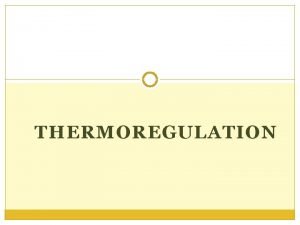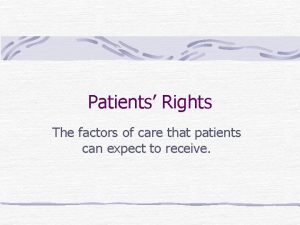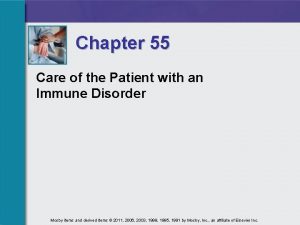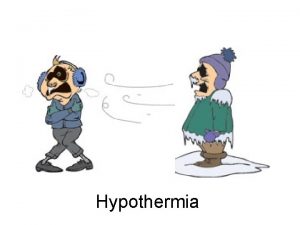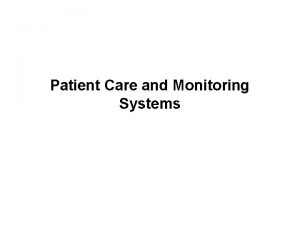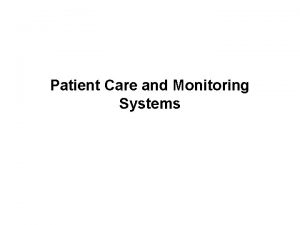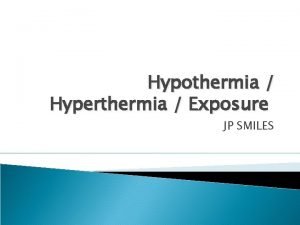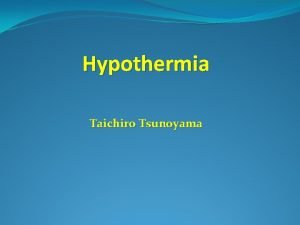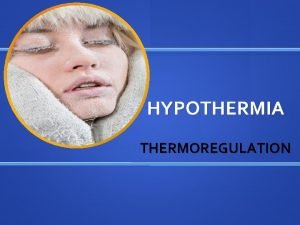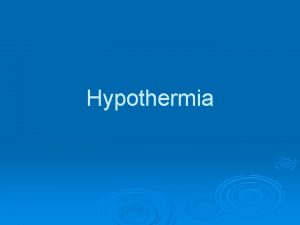CARE OF PATIENT WITH HYPOTHERMIA DEFINITION Hypothermia is












- Slides: 12

CARE OF PATIENT WITH HYPOTHERMIA

DEFINITION Hypothermia is a medical emergency that occurs when your body loses heat faster than it can produce heat, causing a dangerously low body temperature Hypothermia occurs as your body temperature falls below 95 F (35 C).

CAUSES Wearing Staying clothes that aren't warm enough for weather conditions out in the cold too long Being unable to get out of wet clothes or move to a warm, dry location Falling Living into the water, as in a boating accident in a house that's too cold, either from poor heating or too much air conditioning

SYMPTOMS OF HYPOTHERMIA Shivering Slurred speech or mumbling Slow, shallow breathing Weak pulse Clumsiness or lack of coordination

Drowsiness or very low energy Confusion or memory loss Loss of consciousness Bright red, cold skin (in infants)

Assessment The diagnosis of hypothermia is usually apparent based on a person's physical signs and the conditions in which the person with hypothermia became ill or was found. Blood tests also can help confirm hypothermia and its severity.

MANAGEMENT Be gentle. When you're helping a person with hypothermia, handle him or her gently. Limit movements to only those that are necessary. Don't massage or rub the person. Excessive, vigorous or jarring movements may trigger cardiac arrest. Move the person out of the cold. Move the person to a warm, dry location if possible. If you're unable to move the person out of the cold, shield him or her from the cold and wind as much as possible. Keep him or her in a horizontal position if possible.

Remove wet clothing. If the person is wearing wet clothing, remove it. Cut away clothing if necessary to avoid excessive movement. Cover the person with blankets. Use layers of dry blankets or coats to warm the person. Cover the person's head, leaving only the face exposed. Insulate the person's body from the cold ground. If you're outside, lay the person on his or her back on a blanket or other

Monitor breathing. A person with severe hypothermia may appear unconscious, with no apparent signs of a pulse or breathing. If the person's breathing has stopped or appears dangerously low or shallow, begin CPR immediately if you're trained. Provide warm beverages. If the affected person is alert and able to swallow, provide a warm, sweet, nonalcoholic, noncaffeinated beverage to help warm the body.

Use warm, dry compresses. Use a first-aid warm compress (a plastic fluid-filled bag that warms up when squeezed) or a makeshift compress of warm water in a plastic bottle or a dryerwarmed towel. Apply a compress only to the neck, chest wall or groin. Don't apply a warm compress to the arms or legs. Heat applied to the arms and legs forces cold blood back toward the heart, lungs and brain, causing the core body temperature to drop. This can be fatal.

Don't apply direct heat. Don't use hot water, a heating pad or a heating lamp to warm the person. The extreme heat can damage the skin or, even worse, cause irregular heartbeats so severe that they can cause the heart to stop.

THANK YOU
 Difference between frostbite and trench foot
Difference between frostbite and trench foot Temperature hypothermia
Temperature hypothermia Hypothermia suffix
Hypothermia suffix Primary care secondary care tertiary care
Primary care secondary care tertiary care Progressive patient care
Progressive patient care Patient 2 patient
Patient 2 patient What is modular nursing
What is modular nursing Team nursing
Team nursing Qsen examples in nursing
Qsen examples in nursing The factors of care that patient can expect
The factors of care that patient can expect Postoperative nursing management of cataract
Postoperative nursing management of cataract Nursing diagnosis of obsessive compulsive disorder
Nursing diagnosis of obsessive compulsive disorder Chapter 55 care of the patient with an immune disorder
Chapter 55 care of the patient with an immune disorder

